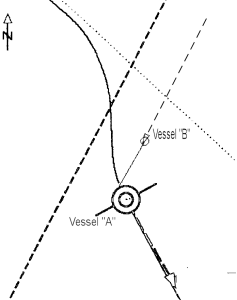The Charity
Aviation
Maritime
Collision Avoidance – Crossing

Initial Report
Report Text:
Vessel “A” on passage in the North Sea in position 52 34N 002 55E, approaching the DW Route a big vessel (“B”) to port on a collision course.
The vessel did NOT show three vertical red lights!!
First contact on Channel 16 abt. at a distance of appr 3.5 miles. An immediate reply followed and went to working channel 6.
I asked him his intentions and that it was his duty to keep clear of me. He answered something like “Why should I…, and I cannot reduce speed”!!
Because of our relatively high speed I could easily cross him by going to starboard.
All the time he kept his course and speed. All the time we had a sufficient CPA, so we have never been in real danger!!
This was a typical example of careless and poor navigation.
CHIRP Comment:
This report was forwarded to the operator of Vessel “B”, who investigated the incident and provided the following comments:
- Vessel “B” was proceeding, in laden condition at a mean draught of 13.82 m when the incident occurred.
- Vessel “B” was in the DW (Deep Water) channel with a course of 207 sailing at a speed of 13.2 kts, and was the give-way vessel, whilst Vessel “A” was on a course of 140 sailing at a speed of abt 21.5 kts.
- The available Bridge Team comprises the Master, the Chief Officer and two (2) 2nd Officers, experienced and properly certified. The 2nd Officer that was OOW has been with the Company for many years. Rest periods were as per ILO and STCW. All navigational equipment was in order and in use.
- As per data submitted by both vessels at 02:50 GMT the 2 vessels were abt 2 nm apart. Had the 2 vessels maintained their course and speed Vessel “A” would have passed from the bow of the Vessel “B” at a CPA (Closest point of Approach) of 0.3 nm.
- Our company’s QMS (Quality Management System) requires a CPA of 2 nm. As per company’s QMS and Master’s standing orders the OOW should have notified the master at least 15 mins before a CPA of 1 nm occurred. Consequently a non-conformity was raised. All above will also be discussed at next Safety Committee Meeting.
- Clearly the root cause was Lack of Compliance with Company procedures.
- As per company’s QMS, and as a result of the near miss in caption, the OOW in question should have undergone additional training upon signing-off. However, in this case the OOW, has retired after his scheduled signing-off at next port.
- As means of preventive action to avoid reoccurrence across the fleet and, according to company’s QMS, an information circular will be distributed to the fleet. Same as per QMS procedures, will be discussed during each vessel’s Safety Committee Meeting.
The Maritime Advisory Board (MAB) are grateful to the operator for sharing the results of their investigation in circumstances where Vessel “B” was clearly at fault for not giving way and for their safety management system response.
It is possible the use of routeing by Vessel “B” caused some confusion in the mind of the OOW as to his status or he may have been overly focussed on maintaining track. It is unlikely, given the size of the vessel, that a reduction in engine speed would have had a significant impact on the vessel’s speed over the ground in the time available.
CHIRP received an additional report on this incident from another vessel in the area suggesting that the situation could have been avoided entirely if Vessel “A” had identified and selected a better opportunity to cross the routeing earlier.
The MAB has previously endorsed the importance of developing an appreciation of the overall situation and the advantages of “defensive navigation” in avoiding situations where the Rules have to be relied on. This approach may not always be possible, but clearly, given the reports appearing regularly in these pages, there remains much to recommend it.








